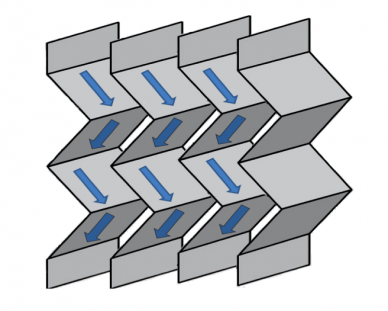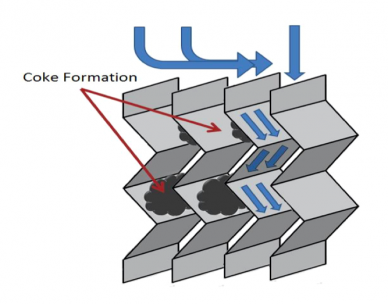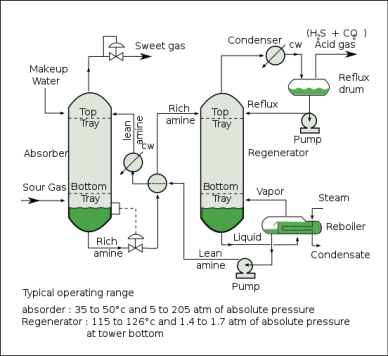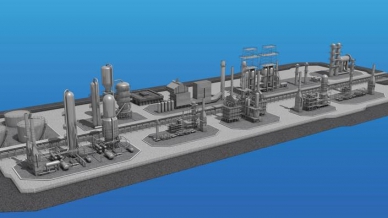
Refineries rely on multipoint thermocouples to monitor temperature at different points inside fixed-bed reactors. However, these temperature measurement systems are also extremely useful for evaluating performance in fluid catalytic cracking (FCC) units, vapor distribution systems, and amine columns.
Refineries all over the world use multipoint thermocouple assemblies in their fixed-bed reactors as a way to monitor catalyst performance and ensure that temperatures stay within an optimal range – key for safe performance and maximum efficiency. But these flexible multi-sensor temperature measurement systems can be put into service in a range of other processes.
Here are three of the applications where multipoint thermocouples are the ideal temperature measurement solutions:
1. Distillation Vapor Distribution Systems
Normally, a portion of the liquid in a refining vacuum tower does not fully separate. Rather, it rises with the vapor stream of vacuum gas oil cuts – both light vacuum gas oil (LVGO) and heavy vacuum gas oil (HVGO) – that feed the downstream catalytic conversion units. To prevent these entrained residue liquids from reaching draw-offs, refineries rely on vapor distribution systems as the primary line of defense.
Under certain wash oil distribution conditions, the packing in the wash bed of the vapor system dries out, and coke begins to form. The problem with coked areas is that they impede liquid flow and, therefore, create vapor-only areas. As the rate of coke formation increases, distribution worsens. There comes a point when the wash bed can no longer properly de-train the liquid, which means contaminants start to enter the HVGO draw-off pool. When this happens, the reactor unit has to be shut down for cleanup, leaving downstream conversion units with no feed.
Multipoint thermocouple assemblies can measure the temperature differential of areas inside a vapor distribution system to warn operators of vapor maldistribution. They can then adjust settings to control coke formation.

Refineries rely on vapor distribution systems to draw off residue liquids.

Coke formations act as dams that impede liquid flow, resulting in a higher concentration of vapor elsewhere in the wash bed.
2. Fluid Catalytic Cracking Units
Fluid catalytic cracking (FCC) units use a catalyst – typically zeolite – to chemically break down (crack) heavy oil fractions into lighter, more valuable products. Startup is one of the most complicated and dangerous steps for an FCC unit. After it is shut down for maintenance, which occurs only every five or so years, the startup process begins with warming up the unit with hot nitrogen and then with steam. If the unit is not hot enough when catalyst is introduced, condensation will occur on the dipleg skin, which wets the catalyst. When catalyst is wetted, it becomes sticky and no longer flows properly. When this happens, operators often have to abort the startup so they can clean the unit and then restart it. This is an expensive and time-consuming interruption.
A multipoint thermocouple assembly measures the diplegs’ temperature so that the metal is above dew point when catalyst is introduced into the system. Operators can also identify any maldistribution and correct it with a “pressure bump” — a controlled reversal before the introduction of hydrocarbons.

Diagram of a typical amine treating process in a refinery or gas plant. Source: Wikipedia Commons
3. Amine Columns
Amine plants use diethanolamine (DEA) or methyldiethanolamine (MDEA) to remove acid gas – carbon dioxide (CO2) and/or hydrogen sulfide (H2S) – from natural gases in syngas plants, gas plants, and refineries.
The amine contactor is a vessel with a countercurrent flow. Clean (lean) amine rains down from the top of the tower, while dirty process gas (sour gas) is injected at the bottom and moves upward. When lean amine comes into contact with sour gas, heat stable salts (HSS) are the byproduct.
The amine is now dirty with HSS, and this rich amine flows out the bottom of the tower and to the stripper column to be regenerated. Meanwhile, clean process gas (sweet gas) goes out the top of the contactor tower.
As amine absorbs these unwanted gases, it heats up. Ideally, this exothermic process should take place about a 1/3 up the tower so that the remaining 2/3 of the length can be used for further “polishing” the gas. The goal is to have only very clean process go out the top.
Optimized multipoint (OMP) thermocouples, also called mini multipoints, can provide a complete temperature profile of the inside of the column. Using this information, operators can thus control the amine flow rate to make sure the hottest spot is near the bottom 1/3 of the vessel.
Multipoint Thermocouple Assemblies from WIKA USA
WIKA designs and manufactures a complete line of multipoint sensor assemblies. Our ETM (electrical temperature measurement) and refinery experts know how to optimize these systems to improve operations in not only fixed-bed reactors, but also vapor distribution systems, FCC units, and amine plants.
Click here to enter our interactive refinery to learn more about WIKA product applications.


